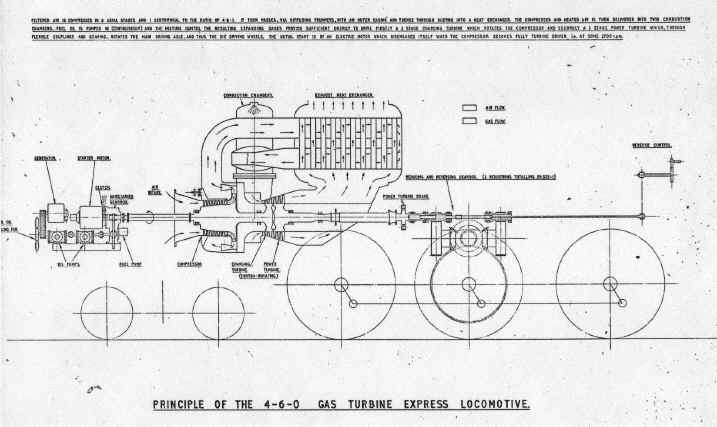Gas Turbine Locomotive GT3
|
Gas Turbine Locomotive GT3 |
| The
GT3 was
originally conceived as part of a programme of Gas Turbine locomotive
development instigated prior to the railways nationalisation during the
late 1940's when all Britain's railways were based around the steam
locomotive with the associated turntables and track that were ideally
suited to the steam locomotive chassis. Nationalisation lead to funding
delays and it was to take 10 years for the locomotive to leave the
drawing board and enter service under test. In fact the construction of
the engine had already been started at English Electric's Rugby works in
the early 1950's where the locomotive was tested without any bodywork on
a bare chassis (see photo below taken sometime between late 1955 and
early 1956) and its completion at the Vulcan Works was more of a favour
than a profitable venture for such a one off.
|
|
GT3 on Test at British Rail's Rugby
Works test bed
|
| Indeed
the 10 year delay from conception to completion had doomed the
locomotive from the start as track improvements and the already advanced
diesel electric programme had all but sealed its fate. The decision to
complete its construction is best viewed as the official closing of
the experimental gas turbine programme with the first locomotive GT1
(BR18000) conceived by the Swiss Locomotive Company with a Brown-Boveri
Turbine being already withdrawn by 1959 after a series of mechanical
failures. GT2 (BR18100) built by Metropolitan Vickers suffered a similar
fate and it was left to GT3 to complete the test programme. The
locomotive was effectively on loan to British Rails London Midland
region and was a very well finished locomotive with a plush carpeted cab
and a very high level of detailing and external finish. The locomotive
was painted in that strange red/chocolate brown colour with yellow and
black lining. Dave Lightfoot remembers that as an apprentice in the
Vulcans drawing office it was parked below the upstairs windows and they
used to eat their sandwiches in it's cab at lunchtime after it had been
handed back to English Electric as a result of an incident at Crewe
station. Apparently the locomotive did not handle corners at speed very well and had struck the platform edgings at Crewe station during a trial
run causing not insignificant damage to the platform. The locomotive
languished at the side of the drawing office for a number of years until
it was stripped of its turbine and other useful bits at the back end of
1965 before the remains were sent to TW Ward's scrapyard in Salford in
February 1966. |
|
|
|
Always keen to make the most capital out of such experimental work the Vulcan used the presence of the locomotive at the works to update its publicity literature with some new photographs that emphasised the versatility of the works. Hence a new photograph was taken on a grey and wet day in december 1960 with GT3 joining the lineup of Vulcan products to show that here was a factory that could basically build any form of modern locomotive.
|
|
GT3 sitting idle in a Siding whilst on BR test.
|
| The
tender at the rear contained the fuel oil which the 2500hp gas turbine
burn't at a profuse rate and the rectangular bulges at the each of the
loco each contained the large number of lead acid batteries required to
start the turbine. The air intakes at the front of each bulge providing
air to ventilate the hydrogen gas produced whilst the batteries charged
during running. |
|
General
Dimensions and Layout of GT3 |
 General Dimensions and Layout of GT3 |
|
GT3 running at speed over Shap
|